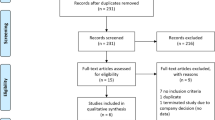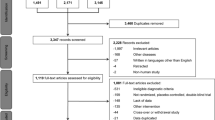Abstract
The phase III randomized clinical trials designed to improve movement symptomatology in initial and advanced stages of Parkinson disease are critically reviewed. This summary provides the reader with an overall clinical picture of the oral therapies that have been tested to treat motor symptoms in PD in the past decade. The responsiveness and interpretability of reported results are considered and a quality of evidence rating scale is proposed to guide the critical review of randomized clinical trials. These recommendations, along with consideration of the large placebo effect in Parkinson disease patients, will hopefully aid in the design of future clinical trials.
Access this chapter
Tax calculation will be finalised at checkout
Purchases are for personal use only
Similar content being viewed by others
References
Postuma RB, Berg D, Stern M et al (2015) MDS clinical diagnostic criteria for Parkinson’s disease. Mov Disord 30:1591–1601
Fox SH, Katzenschlager R, Lim S-Y et al (2018) International Parkinson and movement disorder society evidence-based medicine review: update on treatments for the motor symptoms of Parkinson’s disease. Mov Disord 33(8):1248–1266
Task Force of the Movement Disorders Society, Lang AE, Lees A (2002) Management of Parkinson’s disease: an evidence-based review. Mov Disord 17(Suppl 4):S1–S6
Castro Caldas A, Levin J, Djaldetti R et al (2017) Critical appraisal of clinical trials in multiple system atrophy: toward better quality. Mov Disord 32:1–9
Mizuno Y, Hattori N, Kondo T et al (2017) A randomized double-blind placebo-controlled phase III trial of selegiline monotherapy for early Parkinson disease. Clin Neuropharmacol 40:201–207
Hughes AJ, Daniel SE, Kilford L, Lees AJ (1992) Accuracy of clinical diagnosis of idiopathic Parkinson’s disease: a clinico-pathological study of 100 cases. J Neurol Neurosurg Psychiatry 55:181–184
Pahwa R, Stacy MA, Factor SA et al (2007) Ropinirole 24-hour prolonged release: randomized, controlled study in advanced Parkinson disease. Neurology 68:1108–1115
Hauser RA, Schapira AHV, Rascol O et al (2010) Randomized, double-blind, multicenter evaluation of pramipexole extended release once daily in early Parkinson’s disease. Mov Disord 25:2542–2549
Poewe W, Rascol O, Barone P et al (2011) Extended-release pramipexole in early Parkinson disease: a 33-week randomized controlled trial. Neurology 77:759–766
Schapira AHV, Barone P, Hauser RA et al (2011) Extended-release pramipexole in advanced Parkinson disease: a randomized controlled trial. Neurology 77:759–766
Mizuno Y, Yamamoto M, Kuno S et al (2012) Efficacy and safety of extended-versus immediate-release pramipexole in Japanese patients with advanced and L-dopa-undertreated Parkinson disease: a double-blind, randomized trial. Clin Neuropharmacol 35:174–181
Zhang Z, Wang J, Zhang X et al (2013) The efficacy and safety of ropinirole prolonged release tablets as adjunctive therapy in Chinese subjects with advanced Parkinson’s disease: a multicenter, double-blind, randomized, placebo-controlled study. Park Relat Disord 19:1022–1026
Hauser RA, Hsu A, Kell S et al (2013) Extended-release carbidopa-levodopa (IPX066) compared with immediate-release carbidopa-levodopa in patients with Parkinson’s disease and motor fluctuations: a phase 3 randomised, double-blind trial. Lancet Neurol 12:346–356
Stocchi F, Hsu A, Khanna S et al (2014) Comparison of IPX066 with carbidopa-levodopa plus entacapone in advanced PD patients. Park Relat Disord 20:1335–1340
Pahwa R, Tanner CM, Hauser RA et al (2017) ADS-5102 (Amantadine) extended-release capsules for levodopa-induced dyskinesia in Parkinson disease (EASE LID study). JAMA Neurol 74:941–949
Oertel W, Eggert K, Pahwa R et al (2017) Randomized, placebo-controlled trial of ADS-5102 (amantadine) extended-release capsules for levodopa-induced dyskinesia in Parkinson’s disease (EASE LID 3). Mov Disord 32:1701–1709
Watts RL, Jankovic J, Waters C et al (2007) Randomized, blind, controlled trial of transdermal rotigotine in early Parkinson disease. Neurology 68:272–276
Schapira AHV, McDermott MP, Barone P et al (2013) Pramipexole in patients with early Parkinson’s disease (PROUD): a randomised delayed-start trial. Lancet Neurol 12:747–755
Olanow CW, Rascol O, Hauser R et al (2009) A double-blind, delayed-start trial of rasagiline in Parkinson’s disease. N Engl J Med 361:1268–1278
Stocchi F, Borgohain R, Onofrj M et al (2012) A randomized, double-blind, placebo-controlled trial of safinamide as add-on therapy in early Parkinson’s disease patients. Mov Disord 27:106–112
Schapira AHV, Stocchi F, Borgohain R et al (2013) Long-term efficacy and safety of safinamide as add-on therapy in early Parkinson’s disease. Eur J Neurol 20:271–280
Borgohain R, Szasz J, Stanzione P et al (2014) Two-year, randomized, controlled study of safinamide as add-on to levodopa in mid to late Parkinson’s disease. Mov Disord 29:1273–1280
Schapira AHV, Fox SH, Hauser RA et al (2017) Assessment of safety and efficacy of safinamide as a levodopa adjunct in patients with Parkinson disease and motor fluctuations. JAMA Neurol 74:216–224
Hauser RA, Shulman LM, Trugman JM et al (2008) Study of istradefylline in patients with Parkinson’s disease on levodopa with motor fluctuations. Mov Disord 23:2177–2185
Mizuno Y, Hasegawa K, Kondo T et al (2010) Clinical efficacy of istradefylline (KW-6002) in Parkinson’s disease: a randomized, controlled study. Mov Disord 25:1437–1443
Pourcher E, Fernandez HH, Stacy M et al (2012) Istradefylline for Parkinson’s disease patients experiencing motor fluctuations: results of the KW-6002-US-018 study. Park Relat Disord 18:178–184
Hauser RA, Stocchi F, Rascol O et al (2015) Preladenant as an adjunctive therapy with levodopa in Parkinson disease: two randomized clinical trials and lessons learned. JAMA Neurol 72:1491–1500
Stocchi F, Rascol O, Hauser RA et al (2017) Randomized trial of preladenant, given as monotherapy, in patients with early Parkinson disease. Neurology 88:2198–2206
Ferreira JJ, Lees A, Rocha JF et al (2016) Opicapone as an adjunct to levodopa in patients with Parkinson’s disease and end-of-dose motor fluctuations: a randomised, double-blind, controlled trial. Lancet Neurol 15:154–165
Lees AJ, Ferreira J, Rascol O et al (2017) Opicapone as adjunct to levodopa therapy in patients with Parkinson disease and motor fluctuations a randomized clinical trial. JAMA Neurol 74:197–206
Lees A, Fahn S, Eggert KM et al (2012) Perampanel, an AMPA antagonist, found to have no benefit in reducing “off” time in Parkinson’s disease. Mov Disord 27:284–288
Investigators PSGQ, Beal MF, Oakes D et al (2014) A randomized clinical trial of high-dosage coenzyme Q10 in early Parkinson disease: no evidence of benefit. JAMA Neurol 71:543–552
Postuma RB, Anang J, Pelletier A et al (2017) Caffeine as symptomatic treatment for Parkinson disease (Café-PD): a randomized trial. Neurology 89:1795–1803. https://doi.org/10.1212/WNL.0000000000004568
Sedgwick P (2014) Explanatory trials versus pragmatic trials. BMJ 349:g6694
Scientific Advisory Committee of the Medical Outcomes Trust (2002) Assessing health status and quality of life instruments: attributes and review criteria. Qual Life Res 11:193–205
Wyrwich KW, Wolinsky FD (2000) Identifying meaningful intra-individual change standards for health- related quality of life measures. J Eval Clin Pract 6:39–49
Revicki D, Hays RD, Cella D, Sloan J (2008) Recommended methods for determining responsiveness and minimally important differences for patient-reported outcomes. J Clin Epidemiol 61:102–109
Beaton DE, Bombardier C, Katz JN, Wright JG (2001) A taxonomy for responsiveness. J Clin Epidemiol 54:1204–1217
Cohen J (1988) Statistical power analysis for the behavioral sciences, 2nd edn. Erlbaum, Hillsdale, NJ
Martinez-Martin P, Reddy P, Katzenschlager R et al (2015) EuroInf: a multicenter comparative observational study of apomorphine and levodopa infusion in Parkinson’s disease. Mov Disord 30:510–516
Dafsari HS, Reker P, Stalinski L et al (2018) Quality of life outcome after subthalamic stimulation in Parkinson’s disease depends on age. Mov Disord 33:99–107
Juhász A, Deli G, Aschermann Z et al (2017) How efficient is subthalamic deep brain stimulation in reducing dyskinesia in Parkinson’s disease? Eur Neurol 77:281–287
Mokkink LB, Terwee CB, Patrick DL et al (2010) The COSMIN study reached international consensus on taxonomy, terminology, and definitions of measurement properties for health-related patient-reported outcomes. J Clin Epidemiol 63:737–745
Jaeschke R, Singer J, Guyatt G (1989) Measurement of health status. Ascertaining the minimal clinically important difference. Control Clin Trials 10:407–415
Wyrwich KW, Norquist JM, Lenderking WR, Acaster S (2013) Methods for interpreting change over time in patient-reported outcome measures. Qual Life Res 22:475–483
Hauser RA, Gordon MF, Mizuno Y et al (2014) Minimal clinically important difference in Parkinson’s disease as assessed in pivotal trials of pramipexole extended release. Park Dis 2014:467131
Stefaniak JD, Lam TCH, Sim NE et al (2017) Discontinuation and non-publication of neurodegenerative disease trials: a cross-sectional analysis. Eur J Neurol 24:1071–1076
Hopewell S, Loudon K, Clarke MJ et al (2009) Publication bias in clinical trials due to statistical significance or direction of trial results. Cochrane Database Syst Rev: MR000006
Richens A (2001) Proof of efficacy trials: cross-over versus parallel-group. Epilepsy Res 45:43–47
De La Fuente-Fernández R, Schulzer M, Stoessl AJ (2004) Placebo mechanisms and reward circuitry: clues from Parkinson’s disease. Biol Psychiatry 56:67–71
Shetty N, Friedman JH, Kieburtz K et al (1999) The placebo response in Parkinson’s disease. Parkinson Study Group. Clin Neuropharmacol 22:207–212
Goetz CG, Leurgans S, Raman R, Stebbins GT (2000) Objective changes in motor function during placebo treatment in PD. Neurology 54:710–714
Goetz CG, Wuu J, McDermott MP et al (2008) Placebo response in Parkinson’s disease: comparisons among 11 trials covering medical and surgical interventions. Mov Disord 23:690–699
Goetz CG (2005) Movement disorders: understanding clinical trials. Lancet Neurol 4:5–6
de la Fuente-Fernández R, Schulzer M, Stoessl AJ (2002) The placebo effect in neurological disorders. Lancet Neurol 1:85–91
Mischley LK, Lau RC, Shankland EG et al (2017) Phase IIb study of intranasal glutathione in Parkinson’s disease. J Parkinsons Dis 7:289–299
Frisaldi E, Carlino E, Zibetti M et al (2017) The placebo effect on bradykinesia in Parkinson’s disease with and without prior drug conditioning. Mov Disord 32:1474–1478
Benedetti F, Frisaldi E, Carlino E et al (2016) Teaching neurons to respond to placebos. J Physiol 594:5647–5660
Shin CW, Hahn S, Park BJ et al (2016) Predictors of the placebo response in clinical trials on Parkinson’s disease: a meta-analysis. Park Relat Disord 29:83–89
Hauser RA, Deckers F, Lehert P (2004) Parkinson’s disease home diary: further validation and implications for clinical trials. Mov Disord 19:1409–1413
Hauser RA, Cantillon M, Pourcher E et al (2011) Preladenant in patients with Parkinson’s disease and motor fluctuations: a phase 2, double-blind, randomised trial. Lancet Neurol 10:221–229
LeWitt PA, Guttman M, Tetrud JW et al (2008) Adenosine A 2A receptor antagonist is tradefylline (KW-6002) reduces “off” time in Parkinson’s disease: a double-blind, randomized, multicenter clinical trial (6002-US-005). Ann Neurol 63:295–302
Eggert K, Squillacote D, Barone P et al (2010) Safety and efficacy of perampanel in advanced Parkinson’s disease: a randomized, placebo-controlled study. Mov Disord 25:896–905
Perry B, Herrington W, Goldsack JC et al (2018) Use of mobile devices to measure outcomes in clinical research, 2010–2016: a systematic literature review. Digit Biomarkers 2:11–30
Shulman LM, Gruber-Baldini AL, Anderson KE et al (2010) The clinically important difference on the unified Parkinson’s disease rating scale. Arch Neurol 67:64–70
Hauser RA, Auinger P, Parkinson Study Group (2011) Determination of minimal clinically important change in early and advanced Parkinson’s disease. Mov Disord 26:813–818
Horváth K, Aschermann Z, Ács P et al (2015) Minimal clinically important difference on the motor examination part of MDS-UPDRS. Parkinsonism Relat Disord 21:1421–1426
Horváth K, Aschermann Z, Kovács M et al (2017) Minimal clinically important differences for the experiences of daily living parts of movement disorder society-sponsored unified Parkinson’s disease rating scale. Mov Disord 32:789–793
Mestre TA, Beaulieu-Boire I, Aquino CC et al (2015) What is a clinically important change in the Unified Dyskinesia Rating Scale in Parkinson’s disease? Parkinsonism Relat Disord 21:1349–1354
Author information
Authors and Affiliations
Corresponding author
Editor information
Editors and Affiliations
Rights and permissions
Copyright information
© 2021 Springer Science+Business Media, LLC, part of Springer Nature
About this protocol
Cite this protocol
Kurtis, M.M., Rodriguez-Blazquez, C., Pareés, I. (2021). A Review of Randomized Phase III Pharmacological Clinical Trials for Motor Symptoms in Parkinson’s Disease Patients and Quality of Evidence Recommendations. In: Perez-Lloret, S. (eds) Clinical Trials In Parkinson's Disease. Neuromethods, vol 160. Humana, New York, NY. https://doi.org/10.1007/978-1-0716-0912-5_4
Download citation
DOI: https://doi.org/10.1007/978-1-0716-0912-5_4
Published:
Publisher Name: Humana, New York, NY
Print ISBN: 978-1-0716-0911-8
Online ISBN: 978-1-0716-0912-5
eBook Packages: Springer Protocols




